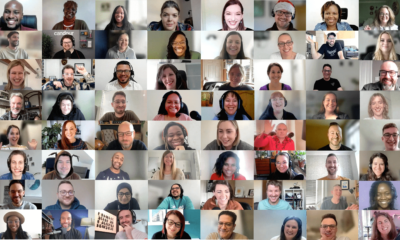MARKETING
Your Audience Isn’t Really Interested in ‘Just the Facts’ Anymore [Rose-Colored Glasses]
![Your Audience Isn't Really Interested in 'Just the Facts' Anymore [Rose-Colored Glasses] Your Audience Isn't Really Interested in 'Just the Facts' Anymore [Rose-Colored Glasses]](https://articles.entireweb.com/wp-content/uploads/2022/01/1642764684_Your-Audience-Isnt-Really-Interested-in-Just-the-Facts-Anymore.png)
Last week, I spoke to a client in the health care industry whose team wanted to develop a new digital content customer experience. But they felt frustrated.
Five years ago, with help from a couple of ad agency consultants, they’d come up with the idea to launch a digital platform to provide easy access to facts. All they needed, they thought, was to set up a digital library that could answer every question existing clients might have.
They would “let the facts speak for themselves” and win the customer retention battle.
<Narrator>: “It didn’t work.”
You see, facts almost never speak for themselves (they’re bashful that way). And they almost never win an argument.
Think about the last time you presented a set of facts you thought would clinch your argument. Boom. You dropped the mic and the knowledge bombs. You won, right?
Nope. Presenting facts does nothing to correct a false belief, and it usually causes your opponents to double down on their beliefs.
A group of researchers actually have studied this so-called “backfire effect” and found that correcting someone “actually increases [emphasis mine] misperceptions among the group in question.”
The backfire effect indicates correcting someone actually increases misperceptions among the group in question, according to #research from @UMich and @GeorgiaStateU via @Robert_Rose @CMIContent. Click To Tweet
In a big data, deep fake world, we have more “facts” than ever before. The question is: Does anyone care what we have to say?
A few years ago, researchers at Wharton showed people various algorithms. Most people in the study found them interesting and valuable – until an algorithm made a mistake. Once people saw the mistake occur, they were “very, very unlikely to use it and didn’t like it anymore.” Study participants seemed to judge algorithms more harshly than they would people, one researcher noted.
But, if these people had input into the algorithm or were allowed to adjust the forecasts, they not only liked the algorithms more, they didn’t lose nearly as much confidence when an error occurred.
These findings bode well for preserving the role of human involvement in an increasingly automated world. But it also speaks volumes in terms of how delicate belief and trust are.
So, the content question in 2022 isn’t about how to present “just the facts.” The question is how to make people care about any of the facts. And this isn’t just a marketing question. It’s a fundamental communication question.
Increasingly, facts are a commodity. They’re easy to attain, so we don’t value them. And because we don’t value them, they can be assailed with … well … “alternative facts.”
Facts are easy to attain, so readers don’t value them, says @Robert_Rose via @CMIContent. Click To Tweet
As I told my health care client, companies have to give people something to believe in (to quote the classic Poison song). You have to give audiences something more than facts to care about.
If you don’t, you risk creating some version of this scene from the TV show The Simpsons: Lisa feels sad because one of her favorite teachers left. Her father, Homer, doesn’t get why. “I knew you wouldn’t understand,” she says. “Hey,” says Homer, “just because I don’t care doesn’t mean I don’t understand.”
Ultimately, with every piece of content, ask this: “Do we want people to care?”
If not, there’s no problem going with the cold corporate template and “let the facts speak for themselves.” If you do want people to care, you better give people more than content they can believe. You better give them content they can believe in – even if it means putting in more effort.
Creating belief is about understanding intent
So, how do you start creating content that goes beyond simple fact-based research, data, and information?
Go back to that argument you had on social media or with the colleague or boss who never seems to “get it.” Think about those customers you’re trying to convince to purchase from you or advocate for you.
You’re never going to win those battles with facts – you must understand why they are arguing, searching, or deciding. You must understand their intent.
To understand intent, you must first create mechanisms – content-driven experiences – that enable your brand to listen more effectively to the signals generated across their interactions.
Create #content-driven experiences to understand audience intent and listen to signals generated by the interactions, says @Robert_Rose via @CMIContent. Click To Tweet
As one might expect, this requires more effective use of data than is likely available for most businesses. A thorough content strategy is needed to provide data to help the business understand each piece of content’s type and purpose and how they apply contextually to each step of the customer’s journey.
What does that content strategy look like?
In my research and consulting practice, I’ve seen marketing organizations create a self-enablement process to create this level of capability. It typically involves a three-step process:
1. Arrange the data house
Create a dictionary or interpretation for understanding intent. Put simply, you need to discern the most appropriate response to the customer’s interaction with your content.
This is where a metadata structure and content tagging system to track behavioral context (or intent) come in. For example, a white paper called Discover How Digital Marketing Is a Good Thing for Your Business might be tagged with a “beginner” or “learning” intent. Someone who consumes this white paper would NOT be considered a lead but will be nurtured as an engaged audience.
2. Develop best next capability
Once you have an intent signal, you need to understand what’s the “best next” thing to make that customer understand and care about the answer.
Businesses need to create content-driven experiences to deliver a “best next” experience to content consumers. For example, that targeted messaging to the beginner or learning audience member should prompt them to want to read a how-to-change piece.
That’s overly simplistic, of course, but you can see how levels of nuance may need to be captured with more than just answers to a question. Through additional content consumption, a poll, or a survey, you can glean if this beginner is feeling confident or fearful about change. As you learn more about the nuanced aspects of the customer’s journey, you can automatically deliver the best next experience for that customer.
Similarly, it’s not all about technology and dynamic content. There’s a human element to this, too. You can share this information with others who can deliver additional experiences that fall outside the digital content realm. For example, you could share insights about the beginner prospect’s behavior with sales. Once sales understands what the prospect needs, their role can evolve from a persuader to a consultant helping the prospect understand the best way to move to the next step.
3. Connect the experiences
This step enables the most insight. Once you map your content to understand what you need to deliver based on intent, you must develop the capability to aggregate this data and serve up the content (and the intent) contextually across the different experiences. You need to find a way to connect the experiences into a singular view of the audience’s progression through their journey.
For example, if the beginner persona ultimately purchases your services, you might want to connect their profile to the onboarding or training module of a 101-level set of training classes. The insight gleaned from a more statistically relevant data set improves these activities or even makes them possible in the first place.
This third step may be the most difficult part of the process because it often means integrating multiple technologies to create a single view of the customer.
But you can start small. Even if you can just connect the intent upper/beginning part of the journey (awareness) to the mid part of the journey (sales), you are starting to get much better.
It’s the content, not the data, that makes people care
Data gives you the opportunity to make people care about what you have to say. To get beyond just “answers,” you must create compelling content that integrates those answers (facts, figures, data, information) into compelling experiences that appeal to the audience’s feelings.
One widespread marketing fallacy is that buyers want factual answers about the products and services they’re considering.
It’s not true. More often than not, the brand that supplies the least information, facts, data, etc., about a product and provides the most inspiration, belief, and emotional connection will be the chosen one.
You need to convince customers they are buying into a brand they can believe in. To do that, you need to give them an experience they believe in, too.
Cover image by Joseph Kalinowski/Content Marketing Institute



















You must be logged in to post a comment Login